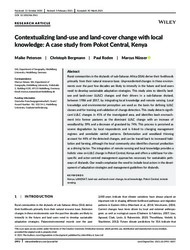Contextualizing land‐use and land‐cover change with local knowledge: A case study from Pokot Central, Kenya
Petersen, Maike; Bergmann, Christoph; Roden, Paul; Nüsser, Marcus, 2021: Contextualizing land‐use and land‐cover change with local knowledge: A case study from Pokot Central, Kenya. In: Land Degradation & Development, Band 32, 10: 2992 - 3007, DOI: 10.23689/fidgeo-4340.
 |
Dokument öffnen: |
Rural communities in the drylands of sub‐Saharan Africa (SSA) derive their livelihoods primarily from their natural resource base. Unprecedented changes in these environments over the past few decades are likely to intensify in the future and land users need to develop sustainable adaptation strategies. This study aims to identify land‐use and land‐cover (LULC) changes and their drivers in a sub‐Saharan dryland, between 1986 and 2017, by integrating local knowledge and remote sensing. Local knowledge and environmental perception are used as the basis for defining LULC classes and for training and validation of change detection. This study detects significant LULC changes in 41% of the investigated area, and identifies bush encroachment into former pastures as the dominant LULC change with an increase of woodland by 39% and a decrease of grassland by 74%. This process is perceived as severe degradation by local respondents and is linked to changing management regimes and unreliable rainfall patterns. Deforestation and woodland thinning account for 44% of the detected changes, and can be traced back to increased habitation and farming, although the local community also identifies charcoal production as a driving factor. The integration of remote sensing and local knowledge provides a holistic view on LULC change in Pokot Central, Kenya and offers a solid base for site‐specific and actor‐centred management approaches necessary for sustainable pathways of drylands. Our results emphasize the need to include local actors in the development of adaptation strategies and management guidelines for drylands.
Statistik:
ZugriffsstatistikSammlung:
- Geographie, Hydrologie [454]
Schlagworte:
KenyaLANDSAT
land‐use and land‐cover change
local knowledge
Pokot Central
remote sensing
This is an open access article under the terms of the Creative Commons Attribution License, which permits use, distribution and reproduction in any medium, provided the original work is properly cited.

